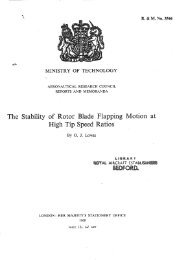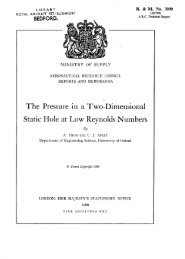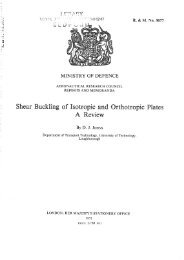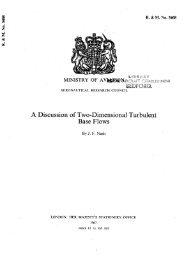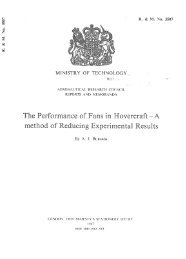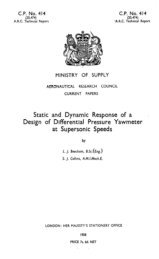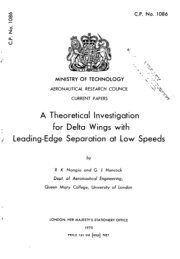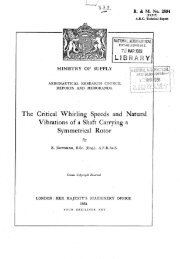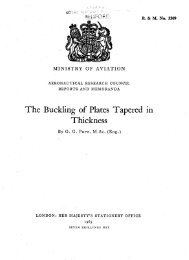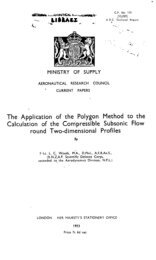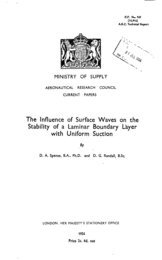Fatigue behaviour of BS 2L65 aluminium alloy pin - aerade
Fatigue behaviour of BS 2L65 aluminium alloy pin - aerade
Fatigue behaviour of BS 2L65 aluminium alloy pin - aerade
You also want an ePaper? Increase the reach of your titles
YUMPU automatically turns print PDFs into web optimized ePapers that Google loves.
12<br />
diagram <strong>of</strong> Fig 35. The local stress diagrams <strong>of</strong> Figs 26 and 27 were then used<br />
with this mean-alternating stress diagram to estimate the lives <strong>of</strong> the bushed<br />
lugs over the range <strong>of</strong> net stresses applied. These estimates are plotted along<br />
with the achieved bushed and unbushed performances in Figs 36 and 37.<br />
Considering first Fig 36, which compares the estimated and achieved<br />
performances at mean stress = 153 (95) NN/m2 it can be seen that the local<br />
stress measurements predicted that fitting a bush would produce a small improve-<br />
ment in endurance over an unbushed lug, typically increasing endurance by a<br />
factor <strong>of</strong> 1.5-2. However, the actual achieved performance <strong>of</strong> a bushed lug was<br />
approximately 6-7 times greater than an unbushed lug over most <strong>of</strong> the alternating<br />
stress range. The predicted and achieved performance curves only converged at<br />
low alternating stresses° Thus, although the local stress measurements predicted<br />
that an interference fit bush should give rise to some improvement in life, the<br />
actual achieved performance was much greater. A possible explanation is that the<br />
interference did reduce fretting damage significantly, and this is the main<br />
reason for the large increase in endurance observed in fatigue tests.<br />
Turning next to Fig 37, which is similar to Fig 36 just described, except<br />
that the mean stress was 225 (140) NN/m 2, it will be noted that the local stress<br />
measurements predicted that the bush would increase endurance <strong>of</strong> the unbushed<br />
lug by a small amount over all the stress range. Again the predictions were in<br />
poor agreement with the observed fatigue <strong>behaviour</strong>. At higher alternating stresses<br />
the bushed lug demonstrated a large increase in performance, which was possibly<br />
due to the reduced fretting damage. However, at low alternating stresses the<br />
performance <strong>of</strong> the bushed lugs was inferior to that <strong>of</strong> the unbushed lugs despite<br />
the fact that local stress measurements indicated that the reverse should have<br />
occurred. This is difficult to understand and does not support the earlier<br />
supposition about the reduced effect <strong>of</strong> fretting.<br />
4.3 The effect <strong>of</strong> aLprestress on bushed an d unbushed lugs under constant<br />
~.~litude loading<br />
As stated earlier, it has already been established by several workers that<br />
t~e ~.~se <strong>of</strong> an i~terference fit bush can improve the f~tigue life <strong>of</strong> lugs under<br />
constant amplitude loading. The main purpose <strong>of</strong> this programme was to investi-<br />
gate the effects <strong>of</strong> bushing under variable amplitude loading. Smith 6 has<br />
reported that whereas a single tensile prestress applied at the beginning <strong>of</strong> a<br />
fatigue test could improve the life <strong>of</strong> an unbushed lug, the reverse was true for<br />
the case <strong>of</strong> a bushed lug. This result implies that large load peaks in a



